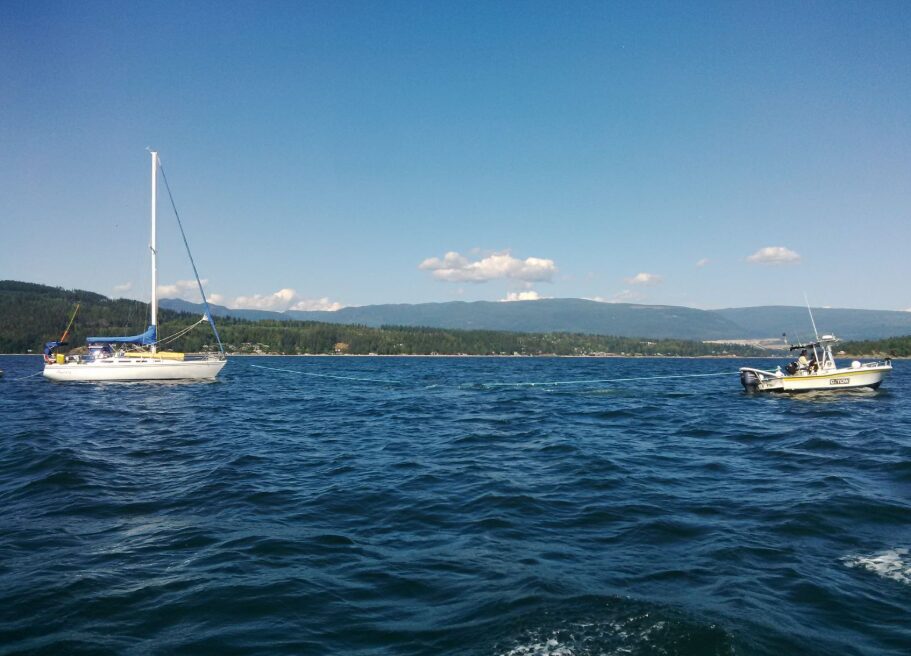
Expert advice from C-Tow’s experienced captains across Canada
Fall boating offers some of the year’s most rewarding experiences, but seasonal changes demand adjusted techniques and heightened awareness. Our captains, with decades of combined experience on Canadian waters, share their essential fall boating wisdom.
“Read the Water Temperature, Not Just the Air”
Captain Steve, BC Coast
“The biggest mistake I see in fall is boaters dressing for the air temperature instead of the water temperature. In September/October, BC might feel warm at 15°C air temperature, but the water could still be 4°C. If you go overboard, you’re dealing with cold water shock and rapid heat loss. Always check water temperatures and dress for immersion, not comfort on deck.”
Morning Fog Navigation Strategy
Captain Tyler, Ontario
“Fall mornings create perfect fog conditions – warm water, cool air. Never push through fog hoping it will clear ‘just around the next point.’ Instead, anchor safely and wait it out, or use these techniques: reduce speed to bare steerageway, post a lookout at the bow, sound your horn regularly (one long blast every two minutes), and have your GPS plotted with waypoints to safe harbors. Most importantly, if you can’t see 100 meters clearly, you’re going too fast.”
Engine Warm-Up Protocol for Cold Weather
Captain Trevor, Lake Simcoe
“Cold fall mornings require patience with your engine. Don’t just turn the key and go – cold engines need time to reach operating temperature. Start your engine and let it idle for at least 5 minutes before putting it in gear. Watch your temperature gauge closely, and don’t push to full throttle until the engine reaches normal operating temperature. This prevents expensive damage and ensures reliable performance when you need it most.”
Fall Weather Window Recognition
Captain Scott, Georgian Bay
“Fall weather systems move fast and hit hard. Learn to read the signs: rapidly building cumulus clouds, sudden wind shifts, and that eerie calm before a front arrives. Always check marine forecasts before departure, but more importantly, watch the sky continuously. If you see towering clouds building to the west, or if the wind suddenly dies when it’s been steady, head for shelter immediately. Don’t wait for the weather radio to tell you what your eyes already see.”
Cold Water Rescue Preparation
Captain Randy, Kawartha Lakes
“In fall, every boater should carry hypothermia prevention gear – emergency blankets, dry clothes in waterproof bags, and hot drinks in thermoses. But here’s the pro tip: practice your man-overboard procedures before you need them. Cold water victims have limited time and mobility. Know exactly how you’ll get someone back aboard, and have all your safety equipment easily accessible, not buried in a locker somewhere.”
Fuel and Range Planning
Captain David, Eastern Ontario
“Fall means shorter days and fewer open marinas. Always carry more fuel than you think you need, and know your backup fuel stops. I recommend the ‘rule of thirds’ in fall: one-third fuel to get there, one-third to get back, and one-third reserve for delays, detours, or helping others. Also, add fuel stabilizer early – you might decide to winterize sooner than planned if weather turns.”
Electronics and Battery Management
Captain Fleet Wisdom
“Cold weather drains batteries faster and can affect GPS and electronics performance. Carry backup power sources, keep electronics warm when possible, and always have paper charts as backup. Most importantly, ensure your VHF radio is working perfectly – in fall conditions, it might be your lifeline to help.”
The Golden Rule of Fall Boating
“When in doubt, don’t go out. When out and in doubt, head in.”
Fall conditions change rapidly, and what starts as a perfect day can turn challenging quickly. The best captains know that discretion is the better part of valor. There’s no shame in turning back or seeking shelter early – there’s only shame in putting yourself, your crew, and rescue personnel at unnecessary risk.
Remember: These tips come from captains who’ve handled thousands of calls across Canadian waters. When conditions exceed your comfort level or equipment capabilities, C-Tow’s professional captains are available 24/7. Our app provides instant access to help, real-time weather updates, and GPS location sharing that can be crucial in fall conditions.
Have a fall boating tip or question? Our captains love sharing knowledge – reach out through our app or contact us directly.
Stay safe, stay prepared, and enjoy the incredible beauty of fall boating on Canadian waters! 🍂⛵
